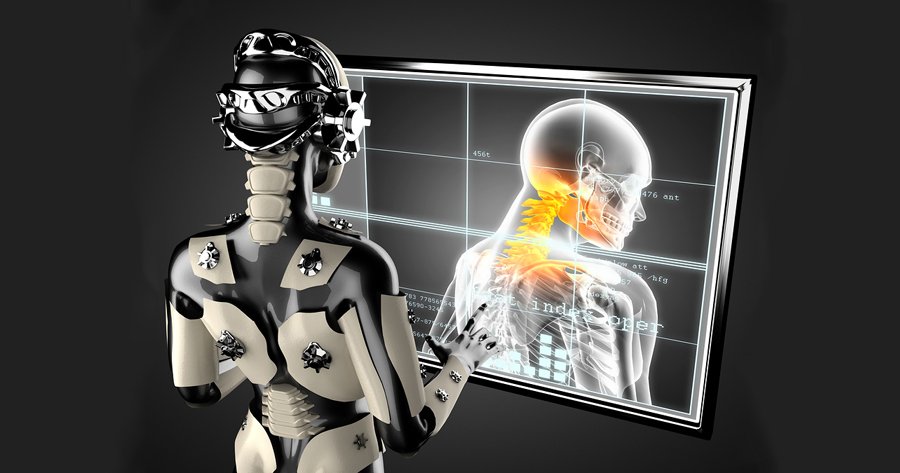“Sorry, the surgeon is in the shop for maintenance.” Those are words that may become common in the next decade. The latest in the ever-expanding deluge of space-age innovations in medicine involves surgery performed completely by robots. If you’re thinking robotic surgery has been around for years, that’s true, but up until now it’s been restricted to “robotic assisted surgery,” and that’s a completely different entity than surgery performed one-hundred percent by robots.
The robotic surgery currently in use is employed primarily for minimally invasive procedures. According to the Mayo Clinic website, “The most widely used clinical robotic surgical system includes a camera arm and mechanical arms with surgical instruments attached to them.1 Mayo Clinic Staff. “Robotic Surgery.” Mayo Clinic. 19 May 2016. http://www.mayoclinic.org/tests-procedures/robotic-surgery/basics/definition/prc-20013988 The surgeon controls the arms while seated at a computer console near the operating table. The console gives the surgeon a high-definition, magnified, 3-D view of the surgical site. The surgeon leads other team members who assist during the operation.”
Notice the use of the word “surgeon” in the above definition. “Surgeon” refers to a human who tells machines what to do. The human needs to identify the site to be operated on and needs to determine the best way to do the job. In fact, the surgeon manually controls the robotic arm, meaning the doc still needs to be steady handed. And, that’s a big problem according to Dr. Peter Kim of the Children’s National Health System in Washington, D.C. He says, “No matter how steady a surgeon’s hands are, there is always some tremor.”
Kim and his associates set out to create a better-than-human alternative to the guy in a white coat, and they claim they’ve succeeded. Although there have been earlier attempts at creating autonomous surgical robots, until now they’ve only been able to do the simplest procedures. But this new “smart tissue autonomous robot,” also known as the STAR, has its own surgical arm, positioning apparatus, and suturing tools, plus several types of high-level built-in imaging devices.2 Shademan, Azal et al. “Supervised autonomous robotic soft-tissue surgery.” 4 May 2016. Science Translational Medicine. 19 May 2016. http://stm.sciencemag.org/content/8/337/337ra64
The main thing that raises it above assistive status is its integrated software that tells it where to place a stitch, and what type of stitch to apply. This includes a 3-D visual tracking system to locate the right spot even when there’s movement, infrared fluorescent imaging that uses luminescent markers to delineate the surgical area, a flexible robotic arm that can add stitches in tight spaces, and sensors that ensure that each stitch gets the right tension and placement.3 Mole, Beth. “First autonomous robot to operate on soft tissue outdoes human surgeons.” 5 May 2016. Ars Technica. 19 May 2016. http://arstechnica.com/science/2016/05/smart-sewing-machine-nails-worlds-first-autonomous-soft-tissue-surgery/
In fact, the robot’s inventors started with an older, cruder model of the robot and kept adding refinements and improvements until a STAR was born. The STAR robot has such sophisticated imaging equipment that it can independently target the soft-tissue site where surgical intervention should occur. Plus, according to an abstract in Science Translational Medicine, it can actually come up with a treatment plan all on its own. “Inspired by the best human surgical practices,” says the abstract, “a computer program generates a plan to complete complex surgical tasks on deformable soft tissue, such as suturing and intestinal anastomosis [ed. reconnecting parts of the intestine].”
The bottom line, of course, is how well the robot performs compared to mere mortals. To test this out, the scientists first experimented on animal tissue in the lab. In those tests, the robot actually performed better than its human counterparts in every metric, including needle placement, stitch spacing and tension, the number of mistakes made, and the potential for the finished seam to leak.
Then, four hapless pigs “volunteered” to allow a STAR robot to perform surgery on their blocked intestines. The STAR robot did the job just fine, although it took considerably longer to complete the surgery than its mortal surgeon counterpart. In fact, the time gap was huge, with the human finishing the suturing in eight minutes, and the machine taking a full 50 minutes. It’s good to know that like that steel driving man, John Henry,4 http://www.youtube.com/watch?v=oEKAwslJ-_M humans still can beat machines on at least one parameter, and time is of the essence in surgical procedures, as the longer one is under anesthesia, the more stress the body experiences. But, the researchers say, the only reason the machines took so long is because they were deliberately programmed to go slowly so that the scientists could monitor them and intervene in time if something went wrong. Speed will no doubt pick up as they remove the software throttles and new refinements get added.
“These results demonstrate the potential for autonomous robots to improve the efficacy, consistency, functional outcome, and accessibility of surgical techniques,” the authors write. For all the heavy praise, though, they stop short of claiming that the robots will ever replace flesh-and-blood doctors. Rather, the point of STAR, they write, is to “expand human capacity and capability through enhanced vision, dexterity, and complementary machine intelligence for improved surgical outcomes.”5 Sorrell, Charlie. “An Autonomous Robot Surgeon Just Successfully Sewed Up a Pig.” 9 May 2016. Co-Exist. 19 May 2016. http://www.fastcoexist.com/3059594/an-autonomous-robot-surgeon-just-successfully-sewed-up-a-pig
The researchers note that it will take some years of testing and tweaking before they’re ready to unleash independent robots in the emergency room, and even then, the robots will always be used only as adjuncts to human doctors. It’s certainly clear that the medical establishment has no interest in letting R2-D2 edge in on its territory any time soon. Case in point: After the FDA approved a Johnson & Johnson Company anesthesiology robot that delivered sedation seemingly as well as MDs, anesthesiologists rose up in protest, claiming that mechanical anesthesiology wasn’t safe. The FDA ended up withdrawing its approval.6 Zhang, Sarah. “Why an Autonomous Robot Won’t Replace Your Surgeon Anytime Soon.” 4 May 2016. Wired. http://www.wired.com/2016/05/robot-surgeon/ It’s hard to know if, in fact, getting anesthetized by a robot is more dangerous than by a human with a medical degree, but it’s a good bet that at least some of the resistance from anesthesiologists was based on self-interest.
No matter how much doctors resist, as science fiction has long predicted, robots are inching in on formerly human territory. We may not be quite ready to accept bedside manner delivered by a mechanical being, but on the other hand, restaurants in China have started using robot waiters that look vaguely humanoid.7 Thompson, Chuck and Yu, Elaine. “New Order? China Restaurant Debuts Robot Waiters.” 20 April 2016. CNN. 20 May 2016. http://www.cnn.com/2016/04/19/travel/china-robot-waiters/ So far, the waiters haven’t performed well, but the trend is clear.
References
| ↑1 | Mayo Clinic Staff. “Robotic Surgery.” Mayo Clinic. 19 May 2016. http://www.mayoclinic.org/tests-procedures/robotic-surgery/basics/definition/prc-20013988 |
|---|---|
| ↑2 | Shademan, Azal et al. “Supervised autonomous robotic soft-tissue surgery.” 4 May 2016. Science Translational Medicine. 19 May 2016. http://stm.sciencemag.org/content/8/337/337ra64 |
| ↑3 | Mole, Beth. “First autonomous robot to operate on soft tissue outdoes human surgeons.” 5 May 2016. Ars Technica. 19 May 2016. http://arstechnica.com/science/2016/05/smart-sewing-machine-nails-worlds-first-autonomous-soft-tissue-surgery/ |
| ↑4 | http://www.youtube.com/watch?v=oEKAwslJ-_M |
| ↑5 | Sorrell, Charlie. “An Autonomous Robot Surgeon Just Successfully Sewed Up a Pig.” 9 May 2016. Co-Exist. 19 May 2016. http://www.fastcoexist.com/3059594/an-autonomous-robot-surgeon-just-successfully-sewed-up-a-pig |
| ↑6 | Zhang, Sarah. “Why an Autonomous Robot Won’t Replace Your Surgeon Anytime Soon.” 4 May 2016. Wired. http://www.wired.com/2016/05/robot-surgeon/ |
| ↑7 | Thompson, Chuck and Yu, Elaine. “New Order? China Restaurant Debuts Robot Waiters.” 20 April 2016. CNN. 20 May 2016. http://www.cnn.com/2016/04/19/travel/china-robot-waiters/ |











